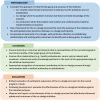Meaningful consumer involvement in cancer care: a systematic review on co-design methods and processes
- PMID: 38897655
- PMCID: PMC11240760
- DOI: 10.1093/jncics/pkae048
Meaningful consumer involvement in cancer care: a systematic review on co-design methods and processes
Abstract
Objective: Although the benefits of consumer involvement in research and health care initiatives are known, there is a need to optimize this for all people with cancer. This systematic review aimed to synthesize and evaluate the application of co-design in the oncology literature and develop recommendations to guide the application of optimal co-design processes and reporting in oncology research, practice, and policy.
Methods: A systematic review of co-design studies in adults with cancer was conducted, searching MEDLINE, CINAHL, Embase, and PsycINFO databases and included studies focused on 2 concepts, co-design and oncology.
Results: A total of 5652 titles and abstracts were screened, resulting in 66 eligible publications reporting on 51 unique studies. Four frameworks were applied to describe the co-design initiatives. Most co-design initiatives were designed for use in an outpatient setting (n = 38; 74%) and were predominantly digital resources (n = 14; 27%) or apps (n = 12; 23%). Most studies (n = 25; 49%) used a co-production approach to consumer engagement. Although some studies presented strong co-design methodology, most (n = 36; 70%) did not report the co-design approach, and 14% used no framework. Reporting was poor for the participant level of involvement, the frequency, and time commitment of co-design sessions. Consumer participation level was predominantly collaborate (n = 25; 49%).
Conclusions: There are opportunities to improve the application of co-design in oncology research. This review has generated recommendations to guide 1) methodology and frameworks, 2) recruitment and engagement of co-design participants, and 3) evaluation of the co-design process. These recommendations can help drive appropriate, meaningful, and equitable co-design, leading to better cancer research and care.
© The Author(s) 2024. Published by Oxford University Press.
Conflict of interest statement
NK reports funding from the Victorian Cancer Agency, Medical Research Future Fund, World Cancer Research Fund, and Medical Nutrition Industry. AU reports funding from the Victorian Cancer Agency, Medical Research Future Fund, and Cancer Australia. SM reports funding from Deakin University. KB and LY report consulting fees from Deakin University. HJ, BB, VW, TL, JB, AB, DS, and SS have no conflicts of interest to report.
Figures



Similar articles
-
Beyond the black stump: rapid reviews of health research issues affecting regional, rural and remote Australia.Med J Aust. 2020 Dec;213 Suppl 11:S3-S32.e1. doi: 10.5694/mja2.50881. Med J Aust. 2020. PMID: 33314144
-
User and carer involvement in the training and education of health professionals: a review of the literature.Int J Nurs Stud. 2007 Mar;44(3):511-9. doi: 10.1016/j.ijnurstu.2006.05.013. Epub 2006 Jul 13. Int J Nurs Stud. 2007. PMID: 16842793 Review.
-
Frameworks for supporting patient and public involvement in research: Systematic review and co-design pilot.Health Expect. 2019 Aug;22(4):785-801. doi: 10.1111/hex.12888. Epub 2019 Apr 22. Health Expect. 2019. PMID: 31012259 Free PMC article.
-
Participatory Methods to Engage Health Service Users in the Development of Electronic Health Resources: Systematic Review.J Particip Med. 2019 Feb 22;11(1):e11474. doi: 10.2196/11474. J Particip Med. 2019. PMID: 33055069 Free PMC article. Review.
-
The future of Cochrane Neonatal.Early Hum Dev. 2020 Nov;150:105191. doi: 10.1016/j.earlhumdev.2020.105191. Epub 2020 Sep 12. Early Hum Dev. 2020. PMID: 33036834
Cited by
-
What can we learn from the evidence of psychosocial support for carers of people with cancer and how do we advance our efforts? A meta-review study.J Cancer Surviv. 2025 May 16. doi: 10.1007/s11764-025-01802-8. Online ahead of print. J Cancer Surviv. 2025. PMID: 40380043 Review.
-
Translating advocacy into action: exploring oncology healthcare professionals' awareness and use of the Clinical Oncology Society of Australia position statement on exercise in cancer care.Support Care Cancer. 2025 Jun 14;33(7):581. doi: 10.1007/s00520-025-09633-0. Support Care Cancer. 2025. PMID: 40515951 Free PMC article.
-
The Development of Heart Failure Electronic-Message Driven Tips to Support Self-Management: Co-Design Case Study.JMIR Cardio. 2024 Nov 7;8:e57328. doi: 10.2196/57328. JMIR Cardio. 2024. PMID: 39509714 Free PMC article.
-
Co-designing interventions to improve emergency department discharge communication with youths, parents and healthcare providers: a process evaluation.Int J Nurs Stud Adv. 2025 Jun 1;9:100362. doi: 10.1016/j.ijnsa.2025.100362. eCollection 2025 Dec. Int J Nurs Stud Adv. 2025. PMID: 40600235 Free PMC article.
-
Stronger together; evaluating consumers and researchers working in partnership.Res Involv Engagem. 2025 May 1;11(1):40. doi: 10.1186/s40900-025-00716-0. Res Involv Engagem. 2025. PMID: 40312742 Free PMC article.
References
-
- Vargas C, Whelan J, Brimblecombe J, Allender S.. Co-creation, co-design, co-production for public health—a perspective on definition and distinctions. Public Health Res Pract. 2022;32(2):e3222211. - PubMed
-
- NHS National Institute for Health Research. Public Involvement in Research: Values and Principles Framework: INVOLVE. Eastleigh: INVOLVE. 2016. https://www.invo.org.uk/posttypepublication/public-involvement-in-resear.... Accessed May 1, 2023.
-
- Patient Centred Outcomes Research Institute. Engagement in Research: PCORI’s Foundational Expectations for Partnerships. Washington, DC: PICORI; https://www.pcori.org/. Accessed November 11, 2023.
-
- National Health and Medical Research Council. Statement on Consumer and Community Involvement in Health and Medical Research. Canberra, ACT: National Health and Medical Research Council; 2016.
-
- American Society of Clinical Oncology. How Advocates Help Create Guidelines. Atlanta, GA, USA: American Society of Clinical Oncology. https://www.cancer.net/blog/2017-03/how-advocates-help-create-guidelines. Accessed May 1, 2023.
Publication types
MeSH terms
Grants and funding
LinkOut - more resources
Full Text Sources
Medical
